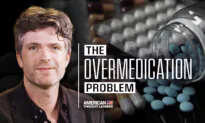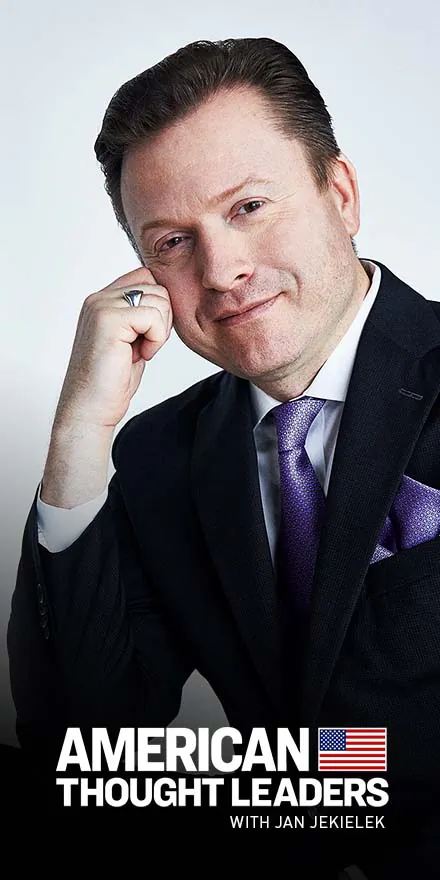Rebecca Friedrichs has a strong sense of justice. It’s what led her to decide to want to be a teacher at the age of 12. It’s also what informed her philosophy as a teacher for nearly three decades, and it’s why she made the difficult decision to stop teaching in order to rescue teachers across the nation from the culture of fear and isolation instituted by teachers unions.
“Teachers have been deceived. They’ve been told that the union is not the problem, the union is their savior, that the administrators and legislators and the school board are the problem, and the parents are the problem. And the union is going to save them,” Friedrichs said.
“What they don’t realize is that their union is the one who put into office the problem legislators, the problem school boards, and those school boards control the problem administrators.”
Teachers, already under tremendous pressure and stress, don’t exactly have the time to do the detective work to discover who is at the bottom of the discipline problems at the school or the problematic curriculum they’re now forced to use. But Friedrichs has connected the dots, and now she wants to get the word out.
Friedrichs is the founder of For Kids and Country, and author of “Standing Up to Goliath,” which recounts her journey of speaking out against state and national teachers unions—political lobbying groups that masquerade as teachers and unions in order to raise money and influence.
Friedrichs said she wrote the book for teachers.
“That’s the whole reason I wrote the book and wrote it from the angle of testimony. Because they didn’t need to hear my opinion, they needed to see the truth, they needed to see pictures of what’s really going on and where, and hear testimony from multiple sources,” she said.
It took a year of sustained focus, of sitting at the kitchen table with 200 note cards, going to bed when her husband was getting up in the morning, interviewing teachers and parents with these long, unjust, harrowing stories to write her book.
“It was a rewarding experience, though, because I came to the point and realized that the only way to help teachers to see the truth was the power of testimony. So that motivated me,” she said.
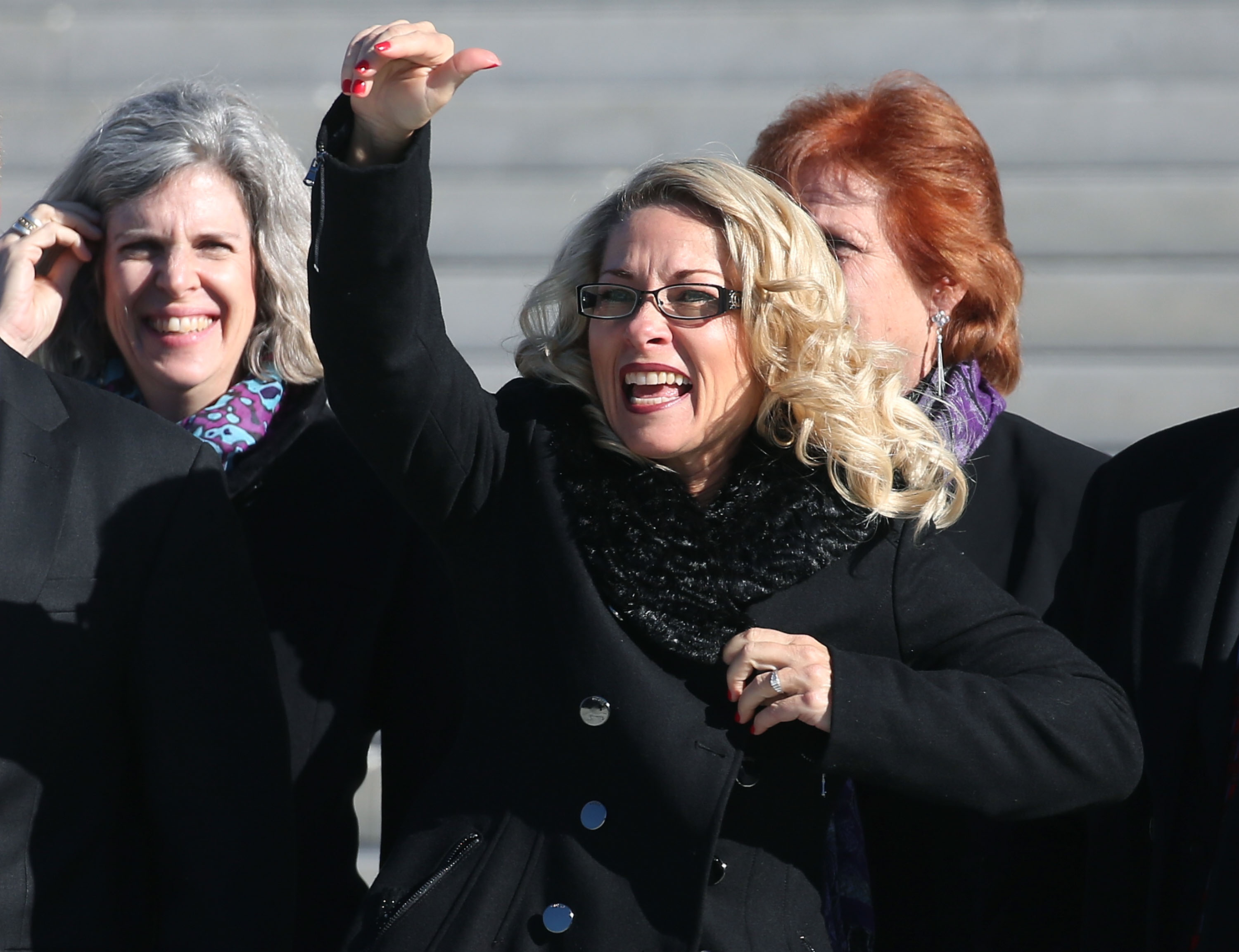
Finding the Big Picture
Friedrichs first witnessed the power of unions early on, even before she was a full-fledged teacher.
As a student teacher, she had a wonderful mentor. But right next door there was a teacher she thought of as “The Witch,” because she would yell and handle the small children in her classroom in a way that was downright abusive. When Friedrichs inquired about filing some sort of complaint, she soon learned that unions had secured that teacher’s tenure, and she could not be fired.
Friedrichs would later learn from another teacher who had been on campus at the same time that this was not an isolated event. That person, too, worked near an abusive teacher who could not be fired.
The book demystifies, chapter by chapter, the stunning myriad of ways that state and national teachers unions can affect schools on the ground level, and many of those ways can come as a surprise. The lack of qualified STEM teachers, the rise of in-school bullying, the radicalization of children, and mass political protests that have nothing to do with education have odd and disturbing ties to these unions.
For instance, the new sex-education curriculum plans that teach how-to’s to 11-year-olds, and have horrified parents who belatedly discovered the content because of the way the material was secretly introduced, was pushed for by these unions. The curriculum contains content so explicit that it can’t be repeated here, but it’s in the book. Friedrichs herself said that as she was writing the chapter, she had to get up and pace the house because the level of abuse on our children was so disturbing, but people needed to know it’s happening.
“They’re changing our history, they’ve undermined our science, they’ve undermined discipline. In most states, parents don’t have the right to see the child’s medical records after age 14—all kinds of stuff unions have pushed off the backs of teachers,” she said.
Science, for example, has literally been redefined to be about “consensus” that includes, rather than is based on, empirical data.
Unions are also the ones funding protests and legislation against school choice, despite so many parents and teachers having seen how it benefits children. Unions have supported baffling legislation that would seem to run counter to education or safety, and pushed back against a federal bill that would prohibit sex offenders from working in schools. They demoted a principal who reported an unfit teacher, and they awarded another for enabling a sex offender. There is a heartbreaking story of an inner-city single mother who tried to get her two girls out of a dangerous school and into a different one. Not only was she jailed and fined, but her elderly father was dragged off to jail where he then passed away.

Teachers Seek Solutions
But it turns out, teachers tend to be fantastic problem solvers.
Friedrichs notes many cases of teachers finding on-the-grounds solutions to the everyday problems they face—but the stories have similar chilling endings. Despite the progress, at some point the unions come in and shut it down.
One such teacher was Aaron Benner, a beloved teacher who taught at a predominantly black public school campus with severe discipline problems. He started a football program during his lunch break, where students learned to live by the motto “Win gracefully, lose gracefully.”
One day, an angry child punched Benner and refused to calm down. Benner took him to the principal’s office, but discovered the student would not be punished. Even the other students thought something wasn’t right.
Benner later found out that their state had paid millions to a consulting firm to come up with a racial equity strategy in schools. He found it full of misleading information, suggesting teachers were punishing students for race, rather than behavior. There were directives from the Obama administration to lower suspension rates for students of color. Racial equity, rather than implementing discipline strategies that work, means often not punishing students who are disruptive.
Many teachers have seen that this strategy leads to lawlessness and chaos on campuses, as students realize they won’t be punished no matter how they act out. The teachers there to teach and students there to learn end up suffering under a fearful and disruptive environment where learning cannot happen.

Unions
But what did this have to do with unions?
As Benner dug deeper, he discovered the racial equity strategy was bargained for by the teachers union—without many teachers in his district even being aware of this. The union had then hired a consultancy to train every employee in the school district to check their “systemic racism.”
He saw wonderful female teachers quit because they faced such physical threat, and if they were white, they would always be accused of being racist. He said a teacher nearly got killed in the district, and instead of marching against violence or having policies that would have protected him, the unions used him as a bargaining chip to bring in more money. He was personally reprimanded for informing a mother when he saw her fourth-grade daughter get punched in the face and knocked out by a boy.
Benner was outspoken, and as a result, he was hit with a series of investigations, including a false claim of harassment. He had paid his union dues, so he did what every teacher would in the situation and turned to the union for representation. The union told him to plead guilty to the faulty claim. He wouldn’t. When Benner later got fed up and said he was going to the press, a representative said not to, because it would make them “look bad.”
As a result, the school lost a great teacher. Benner resigned and later accepted a position as a dean in a private school.
Friedrichs herself has tried to come up with win-win solutions many times in her career. Ten years ago, she served as a local teachers union leader herself in order to try to bring about change from the inside.
At the time, there was a downturn in the economy, and they were told there were budget cuts. The district would have to lay off teachers, meaning the newest teachers, because that’s what the union rules are.
Three of these teachers were ones Friedrichs had mentored herself; they were team players who’d helped improve the district’s writing scores significantly.
Friedrichs did an informal poll of teachers to see if they would be open to taking a small pay cut for the year in order to help these new teachers keep their jobs. Many were supportive of the idea, so Friedrichs brought it up at the next union meeting. She was immediately shut down. She persisted for months, but the union refused to even survey the option. Eventually, union leadership got so annoyed with her, they flat out told her not to worry, because they would make sure these unemployed teachers could take a seminar on how to get unemployment benefits.
She was shocked—they were going to represent these teachers right out of a job.
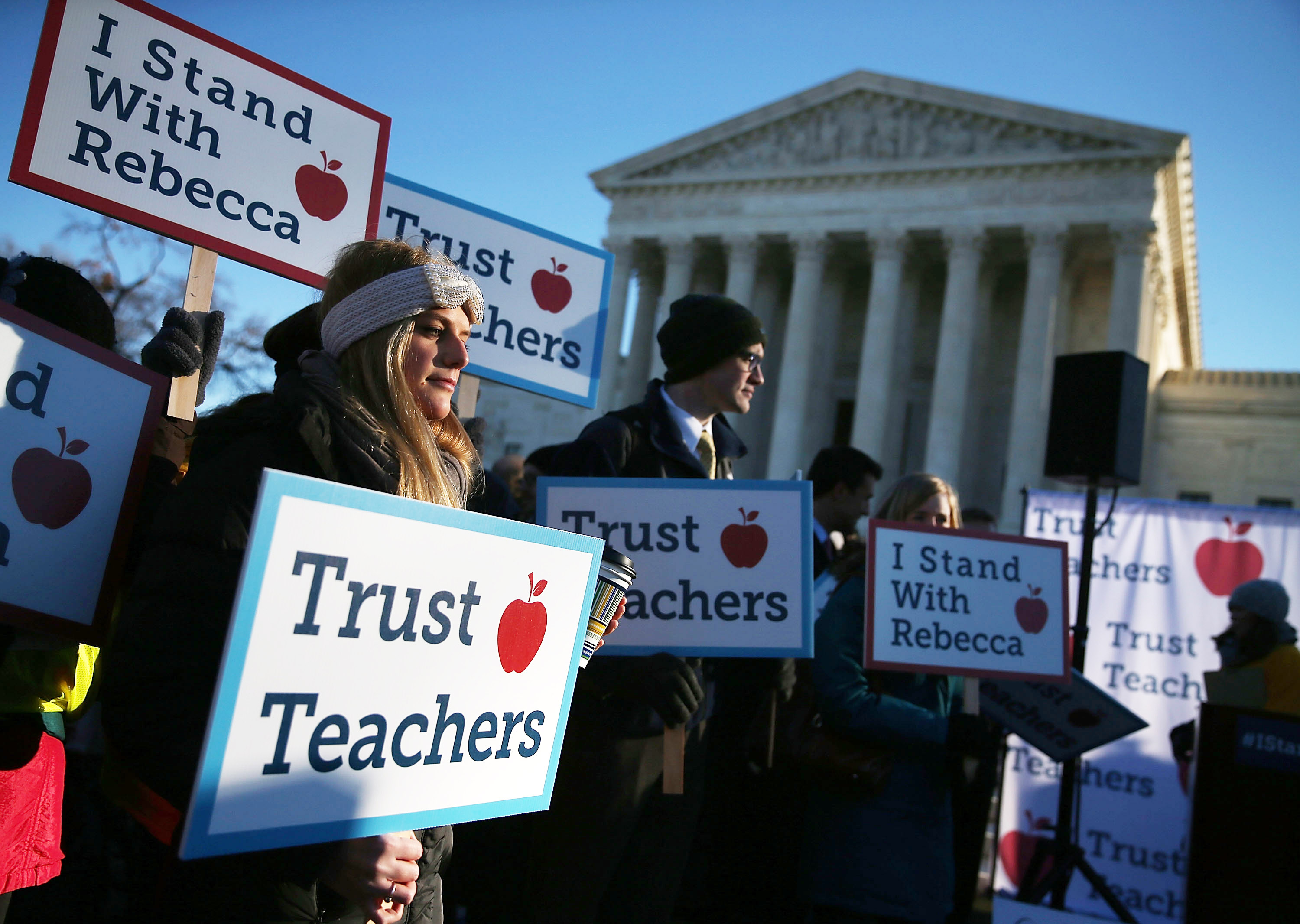
Masquerading
Friedrichs has discovered that unions use four manipulation tactics to keep teachers in line: fear, intimidation, isolation, and ignorance.
“The unions are not only using billions annually provided by teachers tax-free, but they’re also bullying teachers to be boots on the ground for their agenda, including these Red for Ed teacher strikes. Just completely bullying the entire country. Bullying every legislator, bullying every school board, bullying every parent, through teachers,” she said.
There are stories of union leadership screaming at teachers for voicing their opinion or even asking an innocent question about whether this policy will benefit everyone, and the result, time and again, is that teachers learn to be silent. Friedrichs recalled one such instance at a California Teachers Association conference, where ironically there was also a “Bullying 101” workshop available meant to help teachers address campus bullying.
They also now control the parent-teacher associations (PTA), which are now not allowed to be anything but “neutral” on policy, and have very effectively taken parents out of the equation—a move good teachers do not support. Unions are so effective at fearmongering and rallying outrage that one parent trying to improve things through her school board opened her front door one day to find that her front lawn had been stuck with forks, tongs-up, and covered in toilet paper. Her young children could have been seriously injured had they stepped out onto the lawn.
“The hardest part—the word union is a positive word,” she said. “There’s a double whammy because they’re standing behind the profession of teacher, which is highly respected, and standing behind the label of union, which is highly respected. But they’re neither one,” she said. “They’re really political action committees for a radical socialist agenda.”
The book includes statistics spanning several decades, and shows that though the majority of teachers have conservative-leaning views, union spending, which is in the millions, is 100 percent toward liberal causes. And it turns out the state union conferences do teach bullying, in workshops that teach you “how to deal with” conservatives.
Friedrichs found out that the change in teachers unions came in the 1960s. Prior to that, the National Education Association (NEA) had a mission to inspire beauty and wisdom and to pass on a heritage of purpose. It was a call to service, and it promoted the golden rule.
She quotes speeches from NEA leaders who came in during the ’60s and turned it into a political powerhouse—completely funded by public school teachers’ paychecks. They proudly declared that the NEA had been so effective not because it put children or education first, but because they did what unions did best: collective bargaining.
That Friedrichs’s salary was being used to fund political causes she was personally disgusted with seemed to be a constitutional violation.
“Unions are using teacher faces, the teacher profession, teacher money, and gaining unfettered access to America’s kids through teachers. That is crooked and corrupt,” she said. “They’re making billions and billions of dollars off people who never needed them in the first place.”
The divide in politics became the focus of Friedrichs’s 2016 lawsuit.
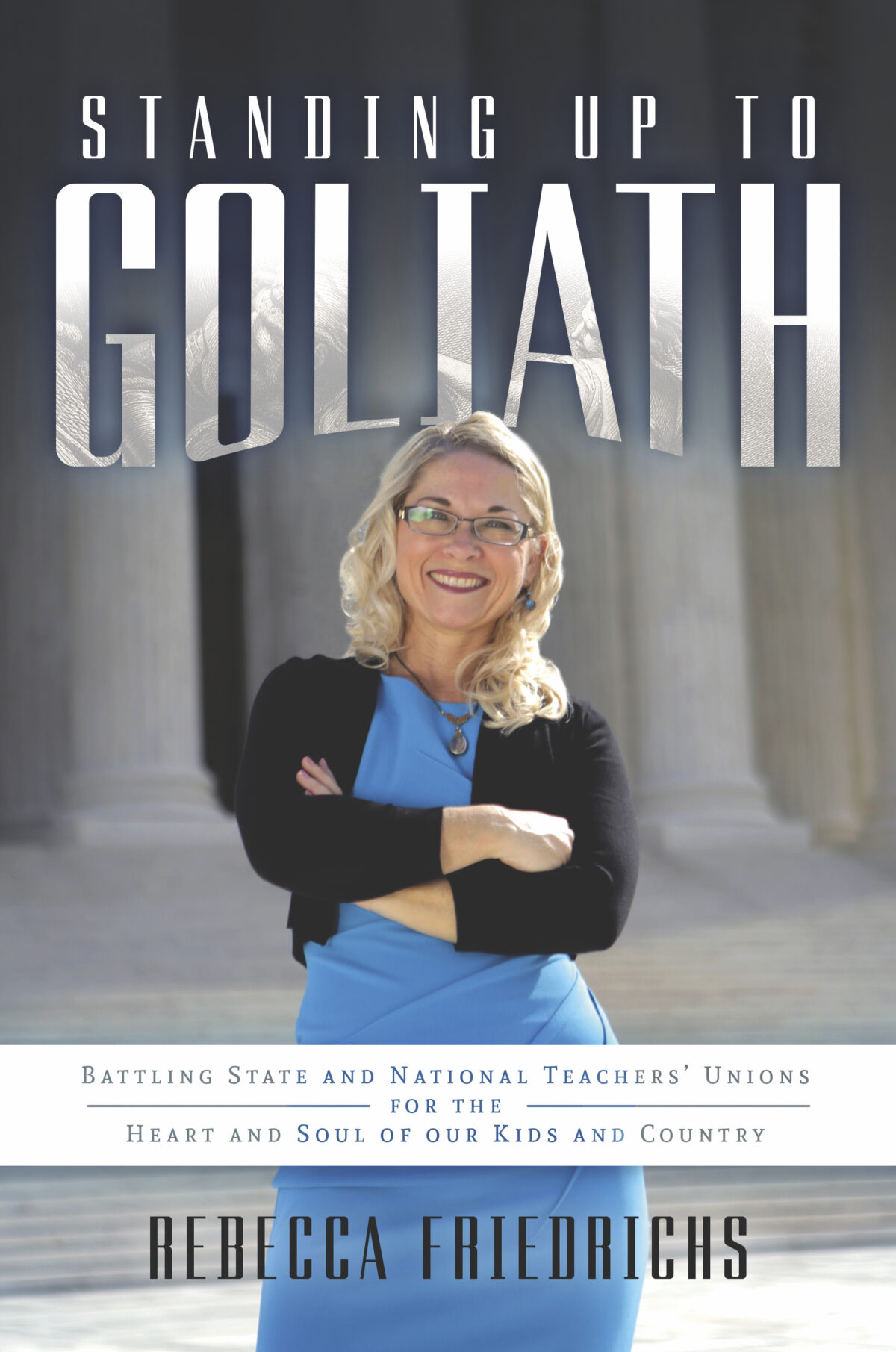
Her 2 Cents
Friedrichs had wanted to be a teacher ever since she was about 12 years old.
She remembered that as a student, teachers would often give information, but not the big picture. Things were taught in isolation, or information would be skipped, and she’d feel lost even though she was a top student.
“I just wanted to help children to understand better. I love that process,” Friedrichs said. “Making something that could seem difficult seem easy. And I just loved it, absolutely loved it. People would ask me, ‘Oh, how can you stand being with little kids all day?’ It was the best job in the whole wide world. I absolutely loved it.”
Friedrichs would get students reading five years below grade level, students labeled “deficit” or “disorder” as her father had been, but she would see that with good education they learned to love reading and love learning.
For Friedrichs, being a teacher meant you were called to service, to be a servant leader. It meant high integrity, honesty, and working very hard to present the truth, and inspire in children lifelong learning, as well as to give them the tools to do so.
Aside from the unions, Friedrichs loved every part of teaching.
After about three years of serving on her local union, Friedrichs had woken up to the stark realization there was no changing unions from the inside. She—like so many of her fellow teachers—was utterly demoralized. Then she turned on the TV, and saw a horrific scene on the news.
People were protesting Wisconsin Gov. Scott Walker’s proposals to rein in pension debt, and teachers were not only faking sick to protest, they closed down schools, attacked students who didn’t agree, defaced buildings, and urinated on the walls inside the capitol building. Damages racked up to $2 million, a bill taxpayers had to foot.
This was the impression America now had of teachers.
Friedrichs was deeply embarrassed; she recognized there were union activists among teachers, but she also knew too many good teachers who cared about their students to believe what she saw was the true picture.
She knew she had to find an audience and tell them the truth.
Friedrichs felt God in her heart, and knew she had to start writing about the injustices instigated by the unions. She had deep reservations, however, and thought she would never get published.
Then the story of the widow’s mite came to mind. She’d known it since childhood.
A poor widow had placed two mites, basically two pennies, into an offering jar, and Jesus pointed it out to the disciples, saying she had given more than all the wealthy because she’d given all she had.
God was telling Friedrichs to give what she had—He would do the rest.
So she did. The first editorial she wrote seemed to go nowhere, but then two days later, California state Sen. Gloria Romero wrote a piece about just that topic. Romero had heard from so many teachers about the abuse they faced from their unions, but they were so afraid, none of them would reveal their identities.
Friedrichs wasn’t afraid to forego anonymity. She got in touch with Romero, who put her in touch with Larry Sand of the California Teachers Empowerment Network. She kept writing editorials, and then gave interviews, and soon Friedrichs’s testimony was heard everywhere.
In 2013, the idea of a lawsuit came up between several teacher support groups. With her family’s support, Friedrichs joined, and ended up as lead plaintiff.
For Christmas, Friedrichs’s sister gave her a necklace. Inside the glass pendant was a unique item, and Friedrichs asked if it was an antique. Her sister told her, “It’s a widow’s mite.”
Friedrichs wore that necklace throughout the lawsuit.
The case was about contesting the forced fees—even if you were not a union member, you were still required to pay fees, which were then used to fund political campaigns the teachers didn’t have a say in.
It looked like it was going to win 5–4, but then with the death of Justice Antonin Scalia, they lost, 4–4. A year later, Mark Janus won his labor case, Janus v. AFSCME, meaning all unionized government employees have the right to opt out of their unions and pay nothing.
There are tremendous implications for teachers, parents, students, and everyone with an interest in the future of the nation.
Adopt a Teacher
Throughout Friedrichs’s activism, she was still teaching. But while she wrote editorials at home and gave interviews to the press, she shut up about it at school.
“I never talked about it at work. At work, I was a teacher, I was there for the kids, I supported my colleagues, and this didn’t come up,” she said.
But the teachers who knew what she was doing would reach out to her secretly. They’d send private emails at home, or have clandestine meetings at the coffee shop because they were so terrified they might be seen with her.
“Teachers are terrified. They’re so bullied. You don’t dare speak against the union. If you say something against the union, it will ruin you,” she said.
“The most common question people ask me is if I’m afraid for my life, so that tells you something about how fearful people are,” Friedrichs said.
Friedrichs wants everyone to know they now have a part to play: Everyone knows at least one teacher, and if you can “adopt a teacher” and pass on the message, things will quickly change.
She’s created a brochure that outlines six steps: embrace, educate, enlighten, empathize, encourage, and empower. Teachers won’t exactly take to the truth easily; they’ll likely be on the defensive—what about their pay, their pension, their liability insurance? She hopes her book will address each of their issues, and that they’ll receive empathy and support, having been alone in this fight for so long.
“People have to get involved,” she said. “The only way to they’re going to break free is personal touch.”
“People go, ‘Oh I’m not going to talk to a teacher, they might get mad at me.’ You know what? Take a risk. Let them get mad at you at first. Do you love them? Do you love your kids? Do you love this republic?” Friedrichs said.
The teachers who have read her book tend to leave their unions—their state and national unions—because they can stay with just their local unions, which very often are teacher-run associations that work for teachers.
Today, Friedrichs travels and speaks on the topic constantly. She’s stepped away from teaching after 28 years with a heavy heart because what she now has to do is more important than her wish to be in her classroom with her students. Someone recently told her that she was still teaching—she was teaching all of America. That cheered her up.
Having seen what she’s seen, she feels we’re at a fork in the road.
“I have hope when good, honest, moral people stand up and fight. But too few are doing that,” she said.
“If good, honest, moral people start to fight, then, yes, I’m very hopeful we could turn things around. We could strengthen and keep our republic quickly and turn things around quickly. But if they don’t, we could lose it quickly.
“Which way are we going to go? Are we going to keep being politically correct and too afraid to speak out?
“If Americans remain cowards, I’m worried. If they’ll stand up and speak out, the good moral people, there’s nothing stopping us.
“Goodness always wins in the end—if it fights.”


 Friends Read Free
Copy
Facebook
Tweet
Friends Read Free
Copy
Facebook
Tweet
















